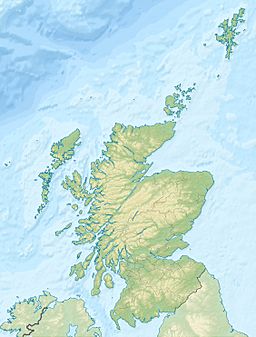Loch Assynt facts for kids
Quick facts for kids Loch Assynt |
|
|---|---|
 |
|
| Location | Sutherland, Scotland |
| Coordinates | 58°10′30″N 5°02′30″W / 58.17500°N 5.04167°W |
| Type | loch |
| Primary outflows | Inver river |
| Catchment area | 69 km2 (27 sq mi) |
| Basin countries | United Kingdom |
| Max. length | 10 km (6.2 mi) |
| Max. width | 1 km (0.62 mi) |
| Surface area | 800 ha (2,000 acres) |
| Max. depth | 86 m (282 ft) |
| Water volume | 247.2 hm3 (200,400 acre⋅ft) |
| Surface elevation | 66 m (217 ft) |
Loch Assynt (which means Loch Asaint in Scottish Gaelic) is a large freshwater loch (a Scottish word for lake) in Sutherland, Scotland. It is located about 8 kilometers (5 miles) east-northeast of Lochinver.
This beautiful loch sits in a stunning area, surrounded by tall mountains like Canisp, Quinag, and Beinn Uidhe. Water flows into Loch Assynt from smaller lochs nearby, such as Lochs Awe, Maol a' Choire, and Leitir Easaich. The water then flows out of Loch Assynt and into the sea at Loch Inver, through a river called the Inver.
The loch is about 9.65 kilometers (6 miles) long. At its widest point, it measures about 1.5 kilometers (1 mile) across. The total area of the loch is around 800 hectares (2,000 acres). It holds a lot of water, about 250 million cubic meters (8.8 billion cubic feet), and its deepest point is about 86 meters (282 feet) down. The surface of the loch is usually about 65.55 meters (215 feet) above sea level, but this can change with rainfall.
Contents
Fishing in Loch Assynt
Loch Assynt is a great spot for fishing! You can find excellent trout here, including sea-trout (which are trout that spend part of their lives in the sea). It's also a good place to catch salmon. Many people enjoy visiting the loch for its peaceful waters and the chance to catch some fish.
Ardvreck Castle: A Historic Ruin
On the northern shore of Loch Assynt, you'll find the ruins of Ardvreck Castle. This old castle sits on a piece of land that sticks out into the loch, west of a village called Inchnadamph.
Ardvreck Castle was once owned by important Scottish families, including the MacLeods and later the Mackenzies. Even though it's now a ruin, it's a reminder of the area's long history and the powerful clans that once lived here.
-
The western end of Loch Assynt with Quinag in the distance
The Mermaid of Assynt: A Local Legend
Around Ardvreck Castle and the village of Inchnadamph, there's a fascinating local story about a "mermaid of Assynt." This legend tells of a young woman named Eimhir, who was the daughter of a MacLeod chief.
Eimhir's Transformation
According to the legend, Eimhir was promised to a devil-like creature known as Clootie. To escape this fate, she didn't jump to her death as some might expect. Instead, she bravely plunged into the deep underwater caves of Loch Assynt. There, she found a new home beneath the water's surface and became the mysterious mermaid of Assynt.
Explaining Nature's Changes
Locals sometimes use this legend to explain natural events. For example, when the water levels in the loch rise higher than usual, people say these are Eimhir's tears, as she mourns the life she lost on land. Some even claim to have seen her weeping on the rocks, now half-woman and half-sea creature.
There are different ideas about what she looks like. Some believe she is a Selkie, a mythical figure from Nordic stories. Selkies are said to be able to change between human and seal form. To become visible to humans again, a Selkie must first shed tears into the water.
Legends and Geology
The legend also tries to explain the unique landscape of Inchnadamph. One part of the story says that Clootie, angry about Eimhir breaking her promise, called down giant rocks from the sky to destroy Inchnadamph and MacLeod's kingdom.
Interestingly, this part of the legend might be connected to real scientific discoveries. Geologists (scientists who study the Earth) have found evidence that northwest Scotland was hit by something from space about 1.2 billion years ago! Scientists from Aberdeen University described this event, saying a "massive impact would have melted rocks and thrown up an enormous cloud of vapour."
Another version of the mermaid legend connects to the creation of the Moine Thrust belt. This is a major geological feature where huge blocks of rock have been pushed over each other. Some believe Clootie's rage caused the Earth to rumble, leading to this massive movement of land. These legends offer a mythical way to understand the amazing and unique geology of the Inchnadamph area.





